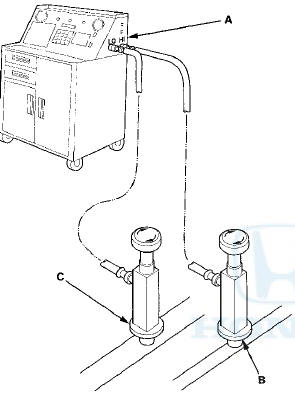 Honda Accord: System Evacuation
Honda Accord: System Evacuation
• Air conditioning refrigerant or lubricant v a p o r c an irritate your eyes, nose, or throat.
•Be careful when connecting service equipment.
• Do not breathe refrigerant or vapor.
NOTE; • If accidental system discharge occurs, ventilate the work area before resuming service.
• Additional health and safety information may be obtained from the refrigerant and lubricant manufacturers.
• Do not allow moisture to contaminate the A/C system oil. Moisture in the oil is difficult to remove, and it can damage the A/C compressor.
1.When an A/G system has been opened to the atmosphere, such as during installation or repair, it must be evacuated using an R-134a refrigerant recovery/recycling/charging station. If the system has been open for several days, the receiver/dryer should be replaced, refrigerant oil should be drained and replaced with new oil, and the system should be evacuated for several hours.
2. Connect a n R-134a refrigerant recovery/recycling/charging station (A) to the high-pressure service port (B) and the low-pressure service port (C), as shown, following the equipment manufacturer's instructions. Recover the refrigerant, if any, from the A/C system (see page 21-80).

3. Evacuate the system. The vacuum pump should run for a minimum of 45 minutes to eliminate all moisture from the system. When the suction gauge reads -93.3 kPa (-700 mmHg, -27.6 inHg) for at least 45 minutes, close all valves, and turn off the vacuum pump.
4. If the suction gauge does not reach approximately - 9 3 . 3 kPa (-700 mmHg, -27.6 inHg) in 15 minutes, there is probably a leak in the system. Partially charge the system, and check for leaks (see page 21-82).
 Refrigerant Recovery
Refrigerant Recovery
• Air conditioning refrigerant or lubricant vapor can
irritate your eyes, nose, or throat.
• Be careful when connecting service
equipment.
•Do not breathe refrigerant or vapor. ...
 System Charging
System Charging
• Air conditioning refrigerant or lubricant vapor can
irritate your eyes, nose, or throat.
• Be careful when connecting service equipment.
• Do not breathe refrigerant or vapor.
...
See also:
Daytime Running Lights
The high beam headlights come on slightly dimmer than normal when the
following
conditions have been met:
The parking/daytime running lights come on when the following conditions have
been ...
Sealing Bolt Installation
NOTE: When installing the sealing bolt (A), always use a
new washer.
...
Low Fuel Indicator Test
1. Do the gauge self-diagnostic test (see page 22-332).
- If the low fuel indicator flashes, go to step 2.
- If the low fuel indicator does not flash, replace the
gauge control module (see page ...
